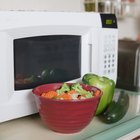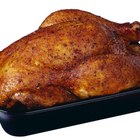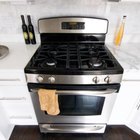
Steam-in microwaveable bags are specially designed to cook and vent the food inside without burning it. If used correctly and according to the manufacturer's directions, these bags are safe to cook vegetables in. Unlike other types of plastic bags, they won't melt and most don't contain harmful chemicals that can transfer onto the vegetables when heated.
Steam Bag Safety
Not all plastic containers or bags are created equally, with some containing dangerous chemicals including bisphenol A, phthalates and dioxin, which could migrate into foods when heated in the microwave. Steam-in bags don't contain these chemicals, making them safe to use in the microwave for the short periods of time as directed by the manufacturer, according to the Fruits and Veggies -- More Matters website. Most plastic steam-in bags are designed for no more than 15 minutes of cooking time in the microwave and for a single use. Using the bags incorrectly, such as for longer times than recommended, may negate their safety.
Microwave Advantages
Cooking vegetables in the microwave is one of the most beneficial way to prepare them because it helps to retain the majority of the vitamins and minerals they contain, advises the Harvard University "HealthBeat" magazine. Boiling your veggies causes them to leach away their nutrients into the water when they are cooked on the stove. Unlike boiling, microwavable steam-in bags need little to no water added to them to cook the veggies inside, which helps them retain their nutrients. You can also add any sauces or seasonings to the veggies that you desire directly in the bag after cooking, but not during the cooking process. These bags aren't designed to cook veggies in sauces, especially high-fat or sugary ones.
Proper Prep and Storage
Prior to cooking your vegetables, wash them thoroughly with running water and remove any damaged, bruised or rotten areas, recommends the U.S. Food and Drug Administration. Before microwaving your vegetables, store them directly in the steam-in bag in the refrigerator for up to two days or two weeks in the freezer. You can cook frozen vegetables safely in a steam-in bag without defrosting them beforehand. After cooking, discard the bag and store leftovers in a separate container. Cook vegetables separately from raw meats to prevent cross-contamination from pathogens in the same bag. For even cooking, chop your veggies into small, equal size pieces.
Cooking and Handling
Foods cooked in steam-in bags are very hot. Use oven mitts when handling the bag and allow it to sit for a minute before opening it slowly to let the hot steam out. Rotate the bag halfway through the cook time and shake the contents to ensure even steaming. Only use the bags in the microwave, not the oven, to cook your vegetables. Some bags are meant to lay flat to cook your veggies, while others are designed to stand up; follow the manufacturer's instructions for the particular bag you are using. Cook your veggies in the steam-in bag to 135 degrees Fahrenheit, recommends the Iowa.gov website.
Related Articles
What Are the Dangers of Boiling Food in ...

How Do Cooking Bags Shorten Cooking ...

How to Make Spaghetti in a Boil Bag

Heating Foods in Plastic & BPA

How to Cook Vegetables in the Microwave
Can We Refreeze Frozen Vegetables?

Rival Seal-a-Meal Vacuum Food Sealer ...

How to Steam Vegetables in an Electric ...

Can You Freeze Cut Carrots, Broccoli & ...

How to Use the Steamer on the Showtime ...

Is It Harmful to Cook Meat in Plastic?

The Steps in Cooking Raw Foods in a ...
Can You Freeze Shish Kabobs?

How to Preserve Rutabagas

Disadvantages of Using Plastic Bags

How to Freeze Pole Beans

Toxins From Reheating Cooked Green ...

How to Get Scratches Out of a Beijo ...

How to Cook With Freeze-Dried Vegetables

Bagel Bites Heating Instructions
References
- Ziploc: Ziploc Brand Zip’n Steam Microwave Cooking Bags
- KFVS12.com: Two Microwave Steam Bags -- Which is Better?
- Fruits and Veggies -- More Matters: Are Steam Cooking Bags Safe?
- Harvard Medical School Family Health Guide: Microwaving Food in Plastic -- Dangerous or Not?
- Iowa.gov: Safe Cooking Temperatures Fact Sheet
- U.S. Food and Drug Administration: Raw Produce -- Selecting and Serving it Safely
- National Food Service Management Institute: Fresh Ways to Cook Fresh Vegetables
Resources
Writer Bio
Based in Las Vegas, Susan Paretts has been writing since 1998. She writes about many subjects including pets, finances, crafts, food, home improvement, shopping and going green. Her articles, short stories and reviews have appeared on City National Bank's website and on The Noseprint. Paretts holds a Master of Professional Writing from the University of Southern California.
Photo Credits
Medioimages/Photodisc/Photodisc/Getty Images